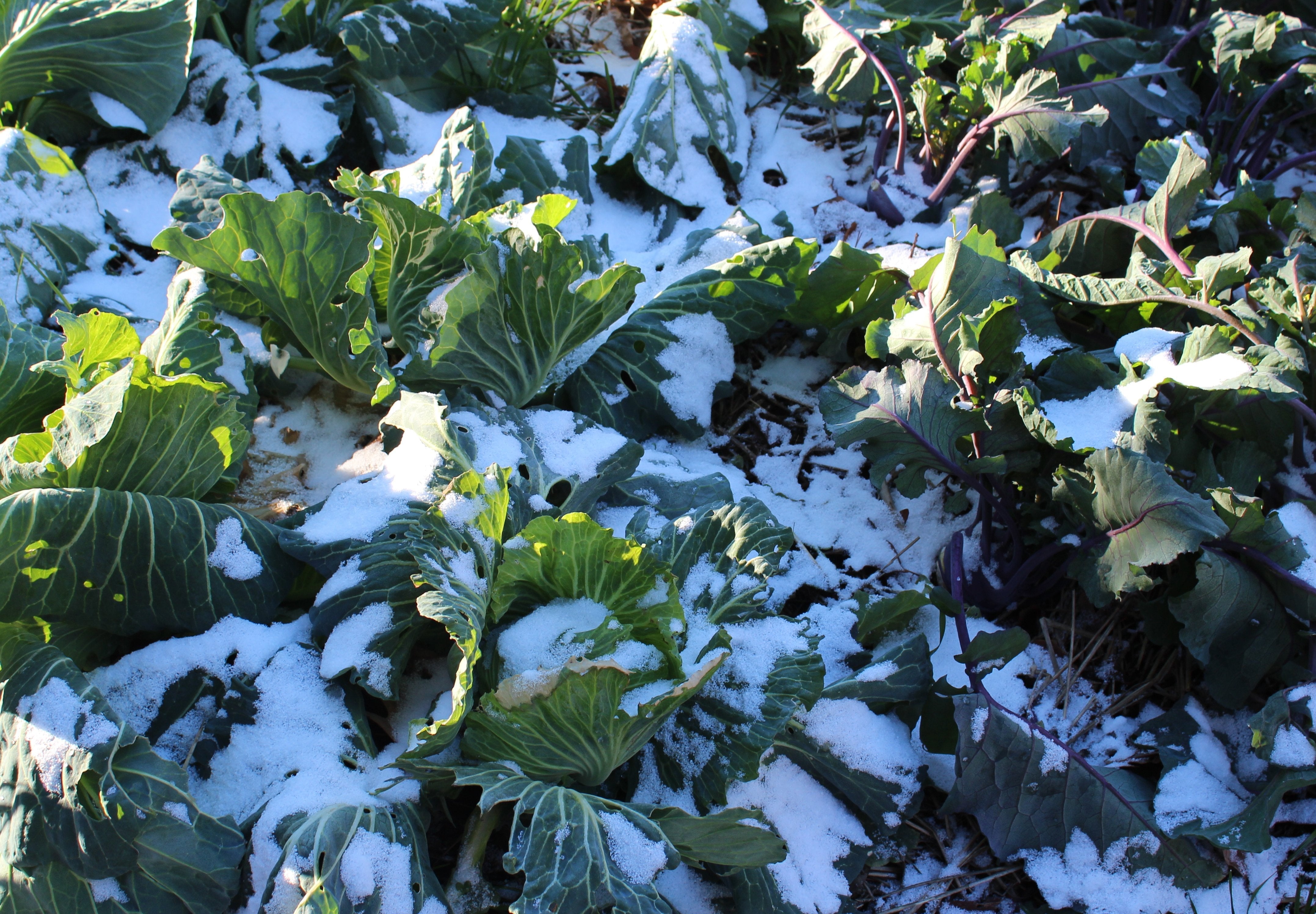There are four basic ways to eat from your garden throughout the winter:
- Plant hardy crops that will overwinter in the garden (sometimes with the help of coverings, but we’ll get into that later).
- Choose “good-keeper” varieties of vegetables for your summer and fall gardens. Store them correctly and enjoy that harvest all winter long.
- Preserve your produce using various methods for later use.
- Try your hand at growing inside!
A combination of these methods will assist in feeding you and your community for the coldest months of the year from the harvests brought by your very own garden. Sometimes planning for this can be a little complicated, but with practice, you’ll find that storage, over-wintering, and preservation actually becomes second nature!
How to Overwinter Vegetables
Depending on where you live and what growing zone you’re in, different vegetables will overwinter and survive a certain amount or severity of frost. There are steps you can take to extend this process as long as possible.
Why Grow in Winter
When we think of winter we think of warm, hearty, heavy foods. It can be difficult to get our fill of fresh vegetables this time of year which can take a toll on the way our bodies feel! With winter gardening we can maximize our ability to get these fresh nutrients into our diets and keep us feeling good and strong all winter long.
The Best Vegetables to Grow in Cold Weather
We recommend trying your hand at root vegetables and leafy greens in your garden. Depending on where you live, many brassicas (kale, cabbage, brussels sprouts, etc.) will overwinter. These species can withstand deep cold and in fact even get tastier with a touch of frost!
Overwintering onions and leeks can also mean fresh alliums in the coldest part of the year! Egyptian Walking Onions, anyone? This perennial allium will offer green onion tops deep into the winter.
Kitchen herbs like thyme, oregano, and parsley can be overwintered in cold frames alongside their tender leafy green counterparts like lettuce and arugula.
While the best vegetables to grow in cold weather may be a shorter list, it certainly isn’t a disappointing one.

Winter Gardening: Season Extension
Season extension is the combination of techniques we use to extend a crop’s growing season either to start earlier or end later than normal. This could look like growing tomatoes in a heated greenhouse as early as March, or using row cover to keep your lettuce from getting frostbitten in November.
Some Tools for Season Extension
There are some tools you can use that are particularly effective in the cold winter months.
-
Black Plastic or landscape fabric
Black plastic can be used as a sort of mulch. You can lay it out over your garden beds and seedlings are planted into it. Not only does it keep weeds down (not that that’s a problem in the dead of winter), but it keeps the soil temperature up to five degrees warmer than uncovered soil.
A lightweight row cover will typically be used in the summer to protect crops from pests but in the winter, a thicker row cover can create a tunnel of warmth around your plants that can be the difference between frost bitten leaves or not. Row Cover of 1.5 ounce or more can offer four to eight degrees of warmth and is best paired with hoops to create what we refer to as a low tunnel. Depending on the thickness, the cover should be removed during the day so it doesn’t block light.
-
Cold Frames
Cold frames can come in many different shapes and sizes and are often built quite cheaply at home. They’re meant to be placed over a garden bed or plant to create a miniature greenhouse situation.

Storing Vegetables Long Term
Cabbage, winter squash, pumpkins, and many root crops like potatoes, sweet potatoes, carrots, and beets will store for a long time into the winter. When these crops are harvested, be sure not to wash them and simply brush off any dirt that may be present. For storage, a root cellar is ideal, though a spare room with a dehumidifier can also work.
Root crops should be left in the ground for as long as possible before the ground freezes. Once harvested, remove any remaining green leaves or foliage and store in bags or crates with decent air circulation. Root crops should always be kept in a humid place without direct sunlight.
Preserving Vegetables
There are many tried and true methods for preserving food. Some of the best methods just so happen to be the easiest! Drying herbs is a great way to keep them and use them for seasoning throughout the winter. This can be done in your oven on a low temperature, in a food dehydrator, or even hanging in a cool, dark place with airflow! Freezing, salting, fermenting, pickling, and canning are also great methods to preserve your food.
Learning about food preservation can certainly be a rabbit hole to dive into but can be easily integrated into your regular garden tasks and harvest routine.

Indoor Gardening
Gardening inside is a great way to get fresh greens right at your kitchen counter. Growing microgreens or sprouting seeds is a low-labor way to do this!
Microgreens
Microgreens are the young seedlings of vegetables. Broccoli, radish, peas, sunflower seed, beets, and chard are only some of the seeds you can use for microgreens! They can be grown on the kitchen counter in a shallow container of soil. They are harvested by cutting away the leafy stems from the roots above the soil line. Typically, they are ready to harvest within two to three weeks depending on the seed you’re using.
Sproutings Seeds
Sprouting seeds, alternatively, are ready to eat within a week. No soil needed. All you need is a jar with a mesh or screen top and a little water! Sprouting seeds are literally the sprouted seed and the entire plant is eaten on sandwiches, salads, or a garnish for soup!
Overwintering vegetables isn’t always easy and can certainly take a learning curve. But the joy of it is, when you try to extend your season, you end up enjoying a much longer harvest than other gardeners. And year after year you learn more and more.
Frosts and deep cold weather can eventually take out nearly any plant, but fear not! At least you won’t be fighting pests!

|
Article Written by: Hannah Gibbons |
|
About the Author: Hannah Gibbons, an employee at Sow True Seed since 2020, has nearly a decade of experience in the agricultural industry. Their passion for environmental education and regenerative agriculture has been the cornerstone of their work, aimed at making gardening accessible to all. |



